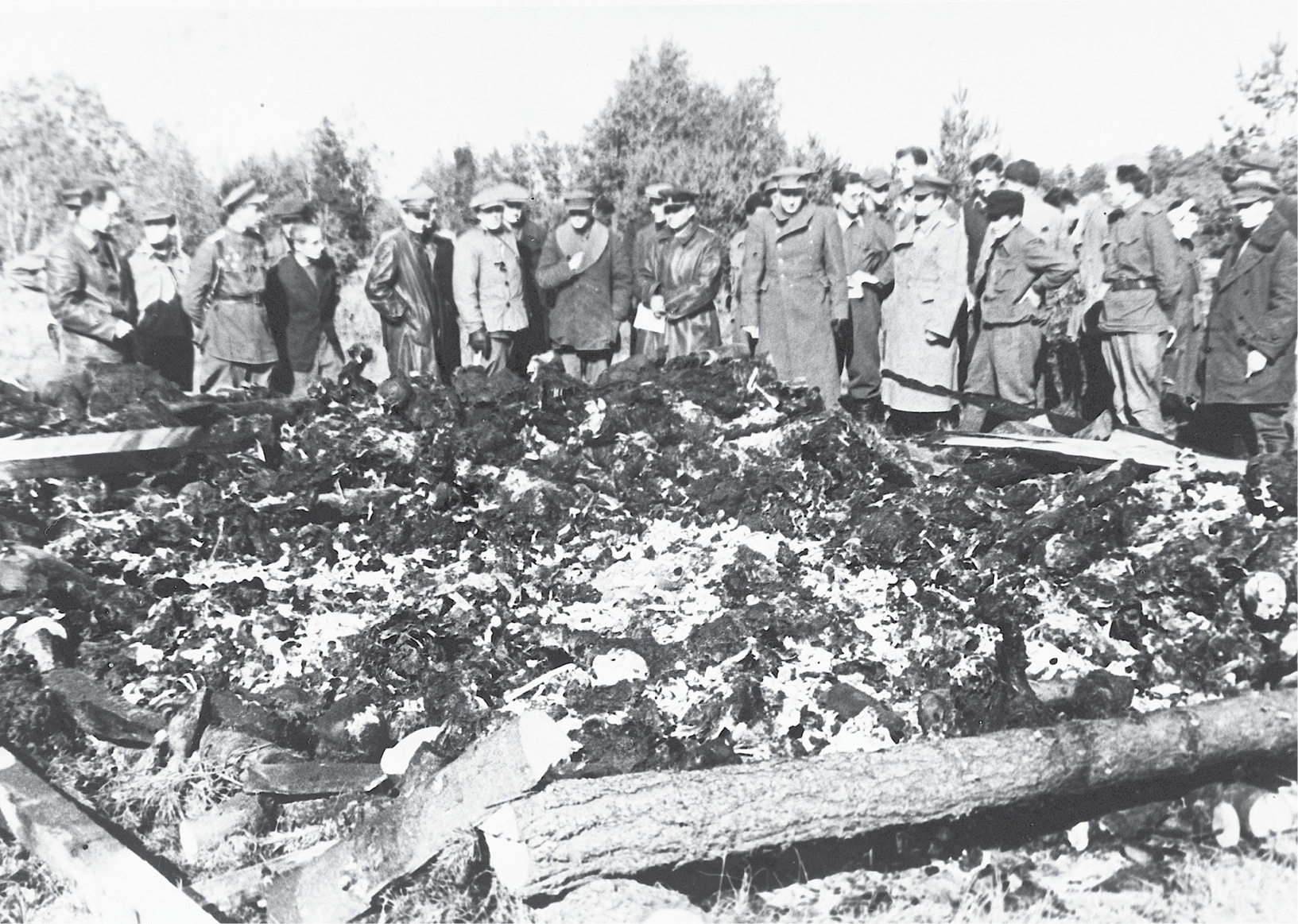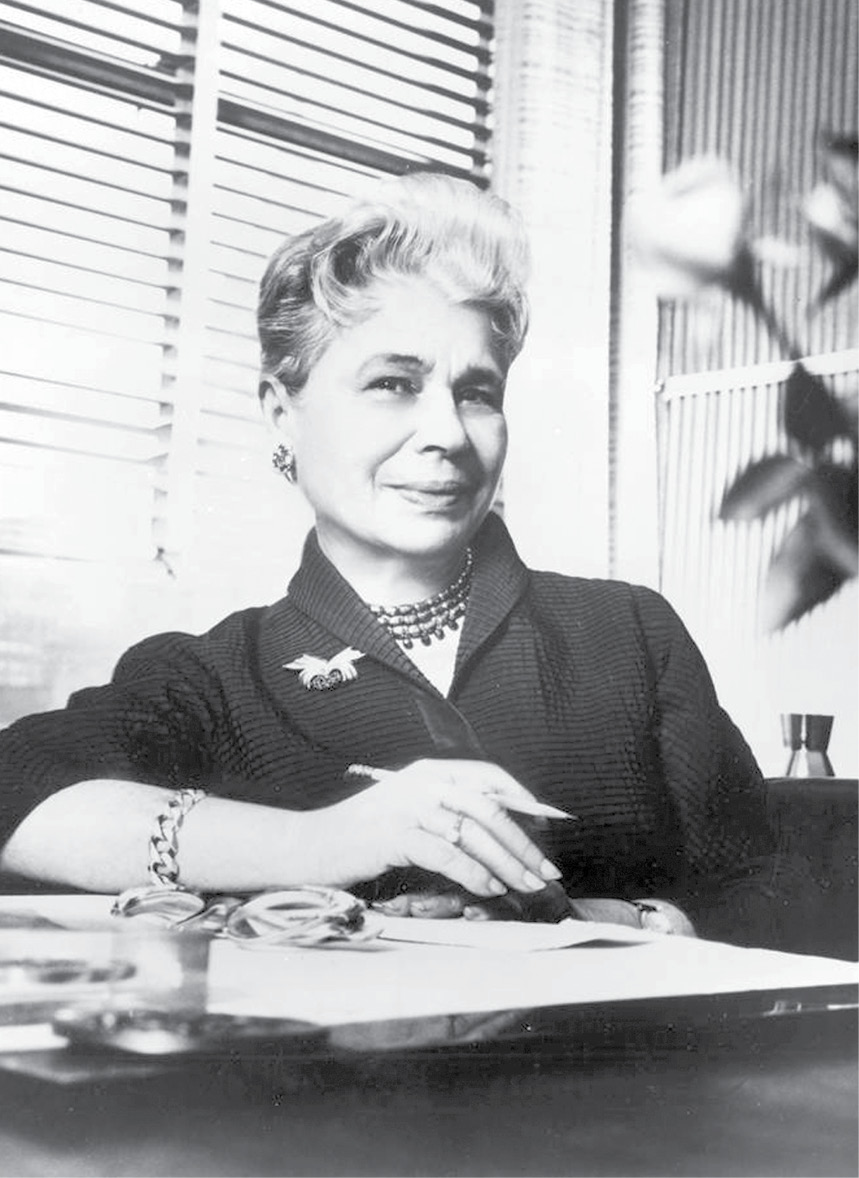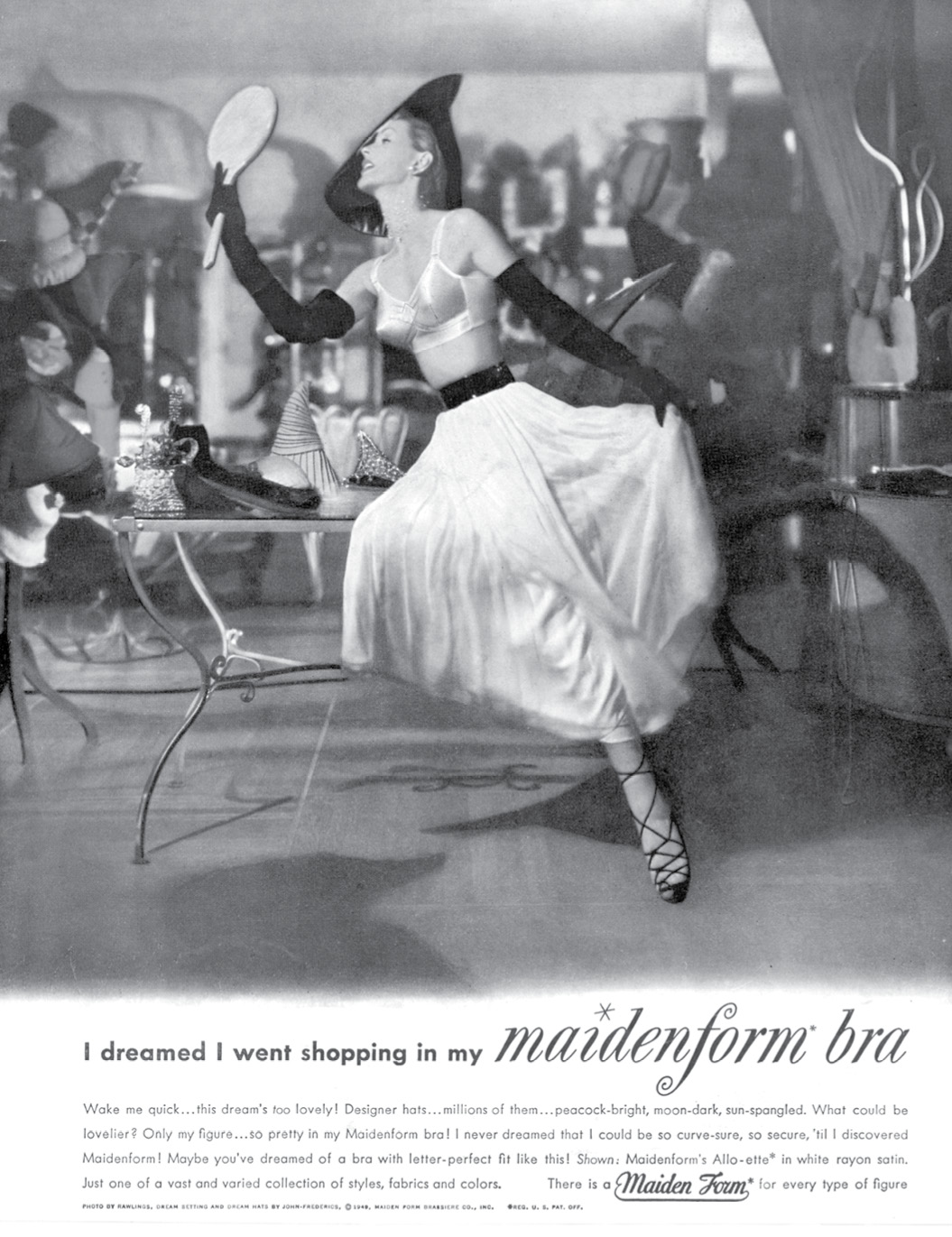Authors: David Laskin
The Family (40 page)

Red Army officials surveying the charred remains of the pyres of logs and corpses at the Klooga slave labor camp in Estonia on September 24, 1944.

Itel, who by the early 1940s was presiding over one of the largest family businesses in the world, with Maidenform's bra and girdle sales topping $4.5 million annually.

The first ad in Maidenform's “dream” campaign, launched in 1949, which became an advertising legendâand sent company profits skyrocketing after the war.
Where to begin?
With my mother, of course. My mother, Leona Cohen Laskin, is and always has been a great storyteller (
a great embellisher
, my father, Meyer, liked to addâto which my mother invariably countered that embellishment was what made a story good) and the stories that ground this book originated with her. So thanks, Mom, for telling, embellishing, editorializing, remembering, and yes, repeating those family storiesâthey all lodged somewhere in my brain, even if I sometimes rolled my eyes or nodded off when you told them. And thanks for connecting me to such a lively, colorful familyâwho knew your relatives would provide so much material?
Sonia's sons, Shimon and Benny Kaganovitz, were my guardian angels throughout: without their partnership, this would have been a very different, and much poorer, book. I really don't know how to thank them enough. Shimon got the whole thing started when he corrected the notion that Lazar Kaganovich was in our familyâand he and Benny have been beyond supportive every step of the way. Shimon, Benny, and their sister Leah were the ideal hosts and guides on my two trips to Israelâthey deftly organized a tour of all the places where their parents had lived; they arranged interviews with key people from Kfar Vitkin, Herzliya, and the Kinneret Colony; they helped me navigate the archives at Ghetto Fighters' House; they
translated for me on many interviews; and they patiently answered hundreds of questions before, during, and after the trips. Benny, to whom this book is dedicated, kept the nearly three hundred family letters that his mother passed downâthough he had never read them because they were all in Yiddish. At my urging Benny had them translated and shared the translations with me. We spent many an hour in Israel and on Skype puzzling over dates, details, and interpretations of these marvelous, heartbreaking letters. Benny and his oldest son, Rotem, interviewed Sonia in 1992, and Benny used this interview as the basis for two beautifully written memoirs of his parents' pioneer days, which he graciously had translated for me. Benny's wife, Orna, wrote me in a recent e-mail that “I try to help Benny when I can in his mission to help you with your book”âand I truly have felt that Benny and his whole extended family in Israel have made this book their mission. All of us were strangers two and a half years agoâand now, as Orna writes, “we are really family in our feelings.” This has been a priceless gift. So a huge
toda
to Shimon and Riki, Benny and Orna, Leah and Avi. I would also like to thank Shimon's oldest son, Amir, and Benny's son Rotem for joining us on our roots trip to Lithuania and Belarus. Thanks also to Leah and Avi's daughter, Galit, for her hospitality and insights into her grandmother Soniaâand to all of the other relatives who treated us with such warmth and love during our stays in Israel.
My oldest daughter, Emily, has been a collaborator from the get-go. Since Emily knows Russian and has a deep grounding in Russian history, I roped her into research early onâin fact, before the beginning. Emily ascertained beyond a doubt that the evil Lazar was not part of our family; she helped me navigate through the various Russian revolutions of the twentieth century; she recommended relevant Russian history books as well as fiction (including Isaac Babel's brilliant “The Story of My Dovecote”); and, despite a broken leg, she put up with my warp-speed travel pace on the first trip to Israel. Emily also accompanied me and the Israeli relatives on our roots trip, and her Russian came in extremely handy in Belarus. My paternal heart burst with pride when Bella, our tireless Belarusian guide, pulled me aside to confide, “You know Emily is something very specialâand her Russian is perfect.” Emily denies itâbut she did pick up some new salty expressions from Bella.
Family! How could I have written this book without them? I began my research in Palm Beach, Florida, by interviewing my cousin Susan Schechet and her father Sol Rubensteinâwho, sadly, has since passed away. Sol was the oldest surviving first cousin of the generation that included Itel, Sam, Sonia, Doba, and Etlâand he worked for Maidenform for many years, so he was the logical place to start my search. Sol and Susan led me to Rose Rubenstein Einziger, Sol's sisterâanother of the first cousins of that generationâand I interviewed her and her daughter Laurie Bellet next in Walnut Creek, California. The other two survivors of that generation are Len and Seymour Cohn, the sons of Herman, the youngest son of Shimon Dov, and I had rewarding conversations with the two of them as well. A special extra thank you to Susan Schechet, who is a family historian in her own right and has answered scores of questions and supplied many dates over the years. It has been great to get to know her branch of the family, including her cousin Ruth Grant and her uncle Irving Guyer. Thanks to Ken Schechet for his hospitality in Palm Beach.
I tried to talk to all the descendants of Avram Akiva and Gishe Sore who might know something about the old days, and I'm pretty sure I succeeded. A special thank you to Barbara and Mort Weisenfeld for help, hospitality, kindness, warmth, and their closeness to my mom all these years. Gail Cohen was among the joyous discoveries of this bookâa wonderful relative I never knew I had. Many thanks to Gail and her husband, Richard Cohen, for their hospitality and exuberance. And more thanks to Gail for arranging what proved to be a crucial interview with her mother, Inda Epstein Goldfarb, and her late father, Irving Goldfarb. Sallie Cohen was on board all the way and supplied stories, photos, confirmation of family stories/myths, and crucial bits of information including Itel's shoe size. Sallie's husband Michael welcomed us warmly on our visits to Portland, Oregon. Many thanks to Marvin Sleisenger, husband of the late Lenore Cohen Sleisenger, for crucial insights, anecdotes, family photos, and hospitality at his lovely home in Marin County, California. My cousin Gary Cohen has been a terrific helpâit was great to reconnect with him and get to know his wife, Lori, and their three kids. Gary presided over my illuminating interview with his father, Marvin Cohen, from whom I gleaned much useful information and many insights. Thanks also to my cousin Jeff Cohen.
Dick Salwitz has been terrific in sending me interviews that his wife, Kathryn, conducted with Maidenform employees and in answering questions about Itel and William. Many thanks also for the family photos.
Other family members who helped include Jay Epstein, the late Adrian Epstein, Rochelle Rogart, Chuck Cohen and his son Laurence, and Bert Cohen.
In the course of researching the book, I connected (through the wonders of the Internet and Twitter) with the “lost” branch of the familyâthe descendants of Avram Akiva's brother Jasef Bear. Many thanks to Devorah Bayer, Jasef Bear's great-granddaughter, for her enthusiasm for this project and for tons of family lore, genealogy, and affection.
I'd also like to thank the extended Rakov familyâAdi Grynholc, Ruth Wilnai, Dan Horowitz, Judy Horowitz Katz, Art Levine, and Linda Kaminsky. A special thank you to Tsipora Alperovich, a heroic and brilliant woman who survived the Shoah and granted me two illuminating and unforgettable interviews in Tel Aviv.
Closer to home, I'd like to thank my brothers, Bob, Dan, and Jon, and Bob's wife, Sue, and oldest son, Isaac, for moral support, listening to long convoluted reconstructions of the family tree, and above all for accompanying me to Israel. In the course of this trip, we honored the memory of our father, Meyer Laskin, who died in November 2010âand we talked and thought a great deal about our family and the meaning of family. Bob and Sue's son Gabe did a crucial interview for me in Israel and answered my questions about the balance sheets and the finances of A. Cohen & Sons during the Depressionâso a big thank you to Gabe as well.
I have great friendsâand patient friendsâwho have listened to me blather on about “the family book” for all these many years. Ivan Doig has furnished moral and professional support and invaluable advice and enthusiasm at all stages. I have followed every suggestion Ivan madeâand I know I have written a better book for it. Thanks to Ivan and his wife, Carol, for innumerable dinners during the course of composition. My dear friend Jack Levison has cheered, advised, commiserated, bolstered, listened (endlessly), and generally had my back in more ways than I can count; our long rambling talks about writing, religion, Bible, spirituality, fate, character, and the manifold magic of alliteration are a continuing source of
joy and knowledge and fresh air. Jack's wife, Priscilla Pope-Levison, has shared insights into how to bring historic figures to life on the page. Thanks to my oldest friends, Jim and Mary Moran, for just being thereâalways. Many thanks to my writer chums Lyanda Lynn Haupt and David Williams for literary comradeship and for sharing many tricks of the trade. Erik Larson has pointed me toward sources of information on the early Nazi years and shared his wisdom on narrative nonfiction, research, and the publishing process over many an enjoyable lunch. It is a privilege to belong to “the mystic company of the Unspeakablesâlong may we lunch, dish, and bolster each other.
Thank you Danielle Mattoon of the
New York Times
for giving me the opportunity of turning my “roots trip” to Israel into an article for the Travel Section.
Many thanks to Dr. Bennett Kaplan for insights at every critical juncture.
I'd like to thank the superb guides who organized our roots trip to Belarus and Lithuania: in Belarus, Bella went above and beyond the call of duty in tracking down family sites and locating people to interview, and Yuri Dorn was helpful as well. In Vilnius, the charming and professional Yulik Gurvitch did an excellent job of merging history with our particular family interests. Thanks also to Galina Baranova for research in the Vilnius archives. In Rakov, I'd like to thank Lutsina, the students of the Ninth Form of the Rakov Pubic School, the director of the Art Gallery Museum, and the man who led us to the site of a Nazi massacre and recounted his boyhood memories. I'm sorry I did not record his name.
Thanks to Mulik Moher at the Kinneret Colony in Israel.
This is the second book for which Jonathan Sarna of Brandeis University has been my “go-to” person for all things Jewish; I'd like to thank him for his generosity, promptness, and superb scholarship.
John LaMont at the Seattle Public Library helped me kick-start my genealogical research. Jewish Gen helped in more ways than I can count: this is a fantastic resource for anyone doing family research, Shoah research, or any type of Jewish genealogical research. Stanley Diamond and Jackie Williams also helped me jump into genealogical research. Eilat Gordin Levitan maintains a wonderful Web site devoted to the shtetlach of our
region of Belarus, including Rakov and Volozhin, and she is a wizard with genealogical research who has helped me in many ways over the years. The staff of the Bayonne (New Jersey) Public Library helped with research into Maidenform. At the Smithsonian I'd like to thank the staff of the Archives Center at the National Museum of American History for helping me access the Maidenform Collection and Nancy Ellen Davis for letting me handle and photograph historic bras and the pigeon vest in the museum's Textile Division.
Aza Hadas did a masterful job of translating the family letters from Hebrew to English and helped me puzzle through various nuances and thorny questions.
I'd like to thank Ben Anolik, Tola Grynholc Urbach, and Adele Grynholc Jochelson for critically important interviews on the Vilna ghetto and the Klooga concentration camp.
For assistance with the history of the Great War and the First Division's role in it, I want to single out Tom Gudmestad: he is a walking encyclopedia of World War I and more than generous in sharing books, knowledge, and insight. Thanks also to Jim Nelson for sharing his in-depth knowledge of the First Division in the Great War and Phyllis Goodnow for doing research at the National Archives. Mary J. Manning, reference librarian at the Colonel Robert R. McCormick Research Center, First Division Museum at Cantigny (Illinois), did research and provided documents on the military careers of Private Hyman Cohen, Captain Joseph Quesenberry, and Captain Len Cohn.
Thank you Salah Mansour of Palestine Remembered for alerting me to the controversial history of the land sale involving Kfar Vitkin.
My neighbor and friend Ewa Sledziewski helped me with all things Polish, including translationâthanks!
A special thanks to the staff in charge of interlibrary loans at the King County Library System here in Western Washington. We are blessed with fantastic librariesâI could not have written this book without the King County libraries, Seattle Public Library, and the huge collection at the University of Washington libraries, especially the Suzzallo and Allen libraries.
Jerry Pruden shared stories and information about Maidenform. David Mann at the Hebrew Institute of Riverdale answered questions about
Avram Akiva's involvement in the founding and the early days of the synagogue that used to be known as the Hebrew Institute of University Heights.
Mary Whisner, the goddess of research, helped with a key bit of research into the land sale that included Kfar Vitkin. I've lost track of how many books of mine Mary has helped me with nowâthree? four? I appreciate it all.
Jen Taylor Friedman, a working
soferet
(female Torah scribe), welcomed us into her New York home and answered many questions about the art, craft, and traditions of the Torah scribe.
I relied on a number of museums and archives for research into the Shoah; in particular I'd like to thank Paul Shapiro, Nancy Hartman, William Connelly, and the staff of the library at the U.S. Holocaust Memorial Museum in Washington, DC; David Silberklang, Estee Yaari, Zvi Bernhardt, Leah Teichthal, and Rita Margolin at Yad Vashem in Jerusalem; the people who work at the archives of Beit Rishonim (Founders' House) in Herzliya; and the staff of the archives at the Ghetto Fighters' House in Israel. I'd also like to thank the staff of the YIVO Institute for Jewish Research at the Center for Jewish History in New York, in particular Leo Greenbaum for his expert research assistance, Ella Levine for tips on traveling to Eastern Europe, and YIVO's executive director Jonathan Brent. Also helpful in providing tips and answering questions about heritage travel to Eastern Europe were Howard Margol, Stephanie Bernstein, Ruth Ellen Gruber, and Jonathan Young.
